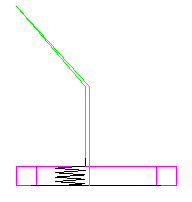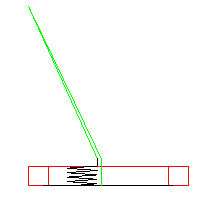Spot drill — Enable this option to add a spot drill operation to the Hole feature.
This operation has some wide-ranging effects, however, especially when used with the Attempt chamfer w/ spot and tool optimization. Of those three settings, tool optimization has the highest priority and its decisions override settings with a lower priority.
For example, a spot drill operation could be performed with either a spot drill or a center drill. Spot drills with a tip angle of 90 can also perform a chamfering operation. You specify a specific tool to cut the hole's chamfer and also turn on
Attempt Chamfer /w Spot and tool optimization. If there is an appropriate spot drill in the tool crib,
FeatureCAM optimizes things and use this tool in spite of your lower priority override. Even though you selected a specific tool, your other settings conflicted with and superseded your choice.
can also perform a chamfering operation. You specify a specific tool to cut the hole's chamfer and also turn on
Attempt Chamfer /w Spot and tool optimization. If there is an appropriate spot drill in the tool crib,
FeatureCAM optimizes things and use this tool in spite of your lower priority override. Even though you selected a specific tool, your other settings conflicted with and superseded your choice.
This is the advantage of the optimization and simulation functions in FeatureCAM. As you work through the optimization settings, and see where you can optimize automatically and where you cannot, you can find ways to group your parts for faster production, but still use specific tools for specific effects when needed.
Spot drill edge break — To create an edge break or chamfer using the spot drill tool, enter the radial distance of the edge break/chamfer. The spot drill creates an edge break/chamfer by cutting deeper than it normally would to create the spot drill operation alone. The default value 0.0050" or 0.1 mm results in a chamfer 0.0100" or 0.2 mm greater than the hole size. The angle of the chamfer depends on the spot drill tool used.
Attempt chamfer w/ spot — Enable this option to try to cut the chamfer during spot drilling. If no available tool can spot and chamfer without gouging the hole, a separate chamfer operation is created.
Spot drill diameter % — This percentage is used to select a spot drilling tool. A value of 100 specifies that the spotdrill should be the same diameter as the hole. A smaller value creates only a starter hole.
Use L/D compensation — This reduces speed and feed for holes that have a ratio of hole depth (L) to hole diameter (D) of greater than 2.5. The greater this ratio, the greater the speed/feed reduction.
Combine similar holes into canned cycle — By default, a tool retracts to the Z rapid plane between operations. Enable this option and then select whether to Retract to the Z rapid plane or the lower Plunge clearance plane after drilling each hole. This option also creates more efficient NC code by entering the canned cycle mode only once.
For example:
|
Retract to Z rapid plane:
|
Retract to Plunge clearance:
|
Drill large counterdrill first — For Counter Drill holes, select this option to do the counterdrill operation before the drill operation.
Ream before chamfer — Enable this option to do the Ream operation before the Chamfer operation. This avoids pushing any kind of burr or edge back up onto the chamfer if the chamfer is a sealing surface.
Machining Type — Select from:
- Drill only — All Hole features are drilled in the traditional way using a drill that is the same size as the hole diameter.
-
Drill/Mill — This option allows Hole features to be drilled or milled, to minimize the number of tools needed.
Click Options to set drill/mill parameters.
Dwell — Enter the amount of time, in seconds, for the spot drill to dwell for a feed-dwell-feed cycle.
Max. tap spindle RPM — This is the maximum speed (in RPM) for tapping.
Drill cycle — This affects how FeatureCAM performs a drill operation. Select one of the following from the menu:
- Deep Hole — The tool pecks and retracts to the Plunge clearance and returns to the previous depth. This cycle is posted using the Deep Hole format in XBUILD.
- Chip Break — The tool stops feeding only to break the chip. This cycle is posted using the Chip Break format in XBUILD.
Tap cycle affects how a tap operation is performed. Select from:
- Floating — Floating and tension-compression holders
- Rigid — This is most commonly available on current machines
- Deep Hole — The tool pecks and retracts to the Plunge clearance and returns to the previous depth.
- Chip Break — The tool stops feeding only to break the chip.
All cycles use the same Tap program format, but logical reserved words exist in XBUILD to distinguish the tap type.
Ream cycle — This affects how a ream is performed. The choices are FDF (feed-dwell-feed), FF (feed-feed), and FSR (feed-stop spindle-retract).
If you select FF, the cycle is posted using the Bore (F-F) format in XBUILD. FDF uses the Bore (F-D-F) format, and FSR uses the Bore (F-S-R) format.
Bore cycle — This affects how a bore is performed. Select one of the following from the menu:
- FF — The cycle is posted using the Bore (F-F) (feed-feed) format in XBUILD.
- FDF — The cycle is posted using the Bore (F-D-F) (feed-dwell-feed) format in XBUILD.
- FSR — The cycle is posted using the Bore (F-S-R) (feed-stop spindle-retract) format in XBUILD.
- No Drag — The cycle is posted using the Bore (No Drag) format in XBUILD.
No drag X shift and No drag Y shift — These attributes affect the amount that the boring tool shifts prior to retracting in No-drag boring.
Pilot diameter(s) — This enables and sets a list of drill sizes used to drill pilot holes. Enter a comma-separated list of drill diameters. For example, entering 0.5, 1, 1.5 in inches, causes holes to be pilot drilled with the half inch drill for final hole sizes up to an inch. A hole in excess of 1.5" is pilot-drilled with all three of the specified drills before being drilled to size. No list of drill sizes turns off pilot drilling for the feature, although this attribute can also be set up as a default for all parts.

